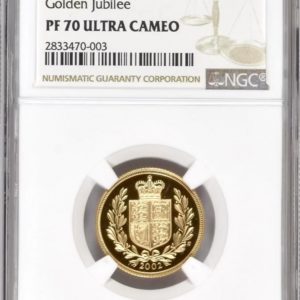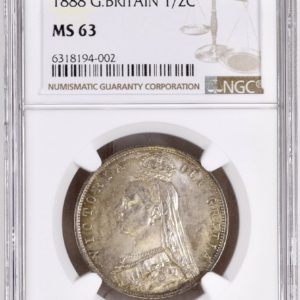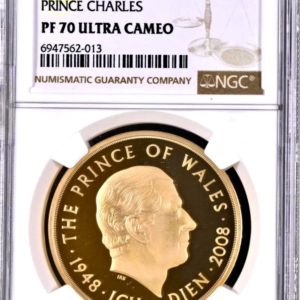
2017 Unicorn of Scotland – Trial Of The Pyx, Gold Proof £100 – Queens Beasts One Ounce Coin
£4,604.68
1 in stock

1 ounce x 999.9 Fine Gold.
Variety: Proof
Maximum Coin Mintage: 418
TRIAL OF THE PYX SINCE 1282
As one of the nation’s longest-established judicial ceremonies, the Trial of the Pyx has a rich and fascinating history. It brings together some of the United Kingdom’s oldest organisations and offices with the purpose of ensuring the quality and accuracy of the nation’s coinage.
The ceremony involves the Chancellor of the Exchequer (or nominated representative), financial leaders, representatives of The Royal Mint and freemen of the Worshipful Company of Goldsmiths, commonly known as The Goldsmiths’ Company.
The word 'pyx' comes from the Latin word 'pyxis' or small box. In this case, it refers to the chests used to transport the coins. Throughout the year, in a procedure that has barely changed since the reign of Henry III, coins are randomly selected from every batch of each denomination struck, sealed in bags of 50 and locked away in the Pyx boxes for testing at the Trial.
'Pyx packets' are taken from the chests and each member of the jury must select one coin at random and place them into a ceremonial copper bowl in front of them for testing. Following the ceremony, the Trial moves into the Assay Office where coins are weighed, measurements are taken and the composition of the metals used is tested.
Once all the coins have been examined and the Assay Office has established whether The Royal Mint has met all requirements, the Trial's court is reconvened at Goldsmiths’ Hall, about three months after the ceremony. For the final phase of the Trial of the Pyx, the verdict of the Assay Office is provided to the jury and is read aloud by the Clerk of the Goldsmiths' Company at the instruction of the Senior Master and Queen’s Remembrancer – an ancient post created in 1154 by Henry II (and the oldest judicial position still in existence).
The medieval protocols of the Trial are a living link to a grandly ceremonial past. The opulent surroundings of the Hall of the Worshipful Company of Goldsmiths’ in London, the judicial robes worn by the jury, the ancient wooden chests and ceremonial copper bowls; the sense of occasion seems to seep into the coins themselves.
Each coin handled by the jury is suffused with a sense of ceremony that sets it apart from their flawless counterparts – these are the actual coins subjected to the rigours of a process unchanged since the time of Henry III.
Every blemish is a reminder of the rigours of the oldest and most exacting minting quality process still in existence today.
Please be aware that the coins have been handled and may have damage from the process.
This coin type is the second from a series of ten coin designs known as the Queen's Beasts.
The Queen's Beasts are British coins issued by the Royal Mint in platinum, gold, and silver since 2016. Each of the coins in the series features a stylized version of one of the heraldic Queen's Beasts statues present at the coronation of Queen Elizabeth II representing her royal line of ancestry. It was announced that engraver Jody Clark will design the entire series; he is best known for also designing the Queen's Fifth definitive portrait, which is on the obverse of the coins.
The Queen's Beasts heraldic statues representing the genealogy of Queen Elizabeth II stood in front of the temporary western annexe to Westminster Abbey for the Queen's coronation in 1953. Each of The Queen's Beasts consists of an heraldic beast supporting a shield bearing a badge or arms of a family associated with the ancestry of Queen Elizabeth II. They were commissioned by the British Ministry of Works from sculptor James Woodford. The statues were uncoloured except for their shields at the coronation. They are now on display in the Canadian Museum of History. There are other statues of the Queen's Beasts, sometimes referred to as the King's Beasts, at Hampton Court Palace and Kew Gardens in London, and on the roof of St George's Chapel, Windsor Castle.
The Unicorn of Scotland comes from the Royal Arms of Scotland. From the end of the 16th century, two unicorns were adopted as the supporters of the Scottish Royal Arms. In 1603, the crown of England passed to King James VI of Scotland, who then became King James I of England. He took as supporters of his Royal Arms a crowned lion of England and one of his Scottish unicorns. The unicorn holds a shield showing the Royal Arms of Scotland, a lion ramping in a royal tressure, adorned with fleur-de-lis.
The reverse features the Unicorn of Scotland standing on its hind legs, holding the Shield of the Royal Arms of Scotland, chained with a coronet around its neck like a collar. According to legend, the unicorn is a very dangerous beast, for which reason on its heraldic representation it is chained. It is thought that the chain was to show a great beast had been tamed to serve the king. As with most chained beasts in heraldry, its strength is emphasised rather than diminished by its shackles.
Around below, the inscription UNICORN OF SCOTLAND. Around above, interrupted by the unicorn's head, the date · 2017 ·.
The artist's initials JC (for Jody Clark) are in the lower left field next to the shield.
Rest assured all photographs are of the actual coin you will receive.
All postage including overseas shipping is fully tracked and insured.
Payment within 24 hours please.
All products to U.K. will be posted Royal Mail Fully Insured next day Special Delivery.



